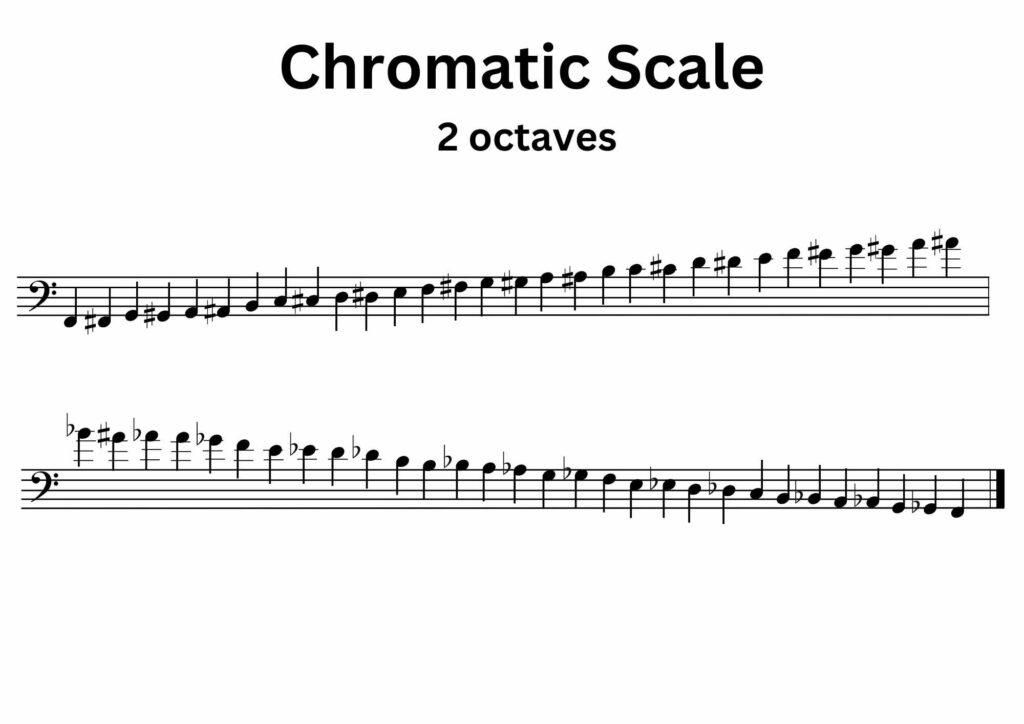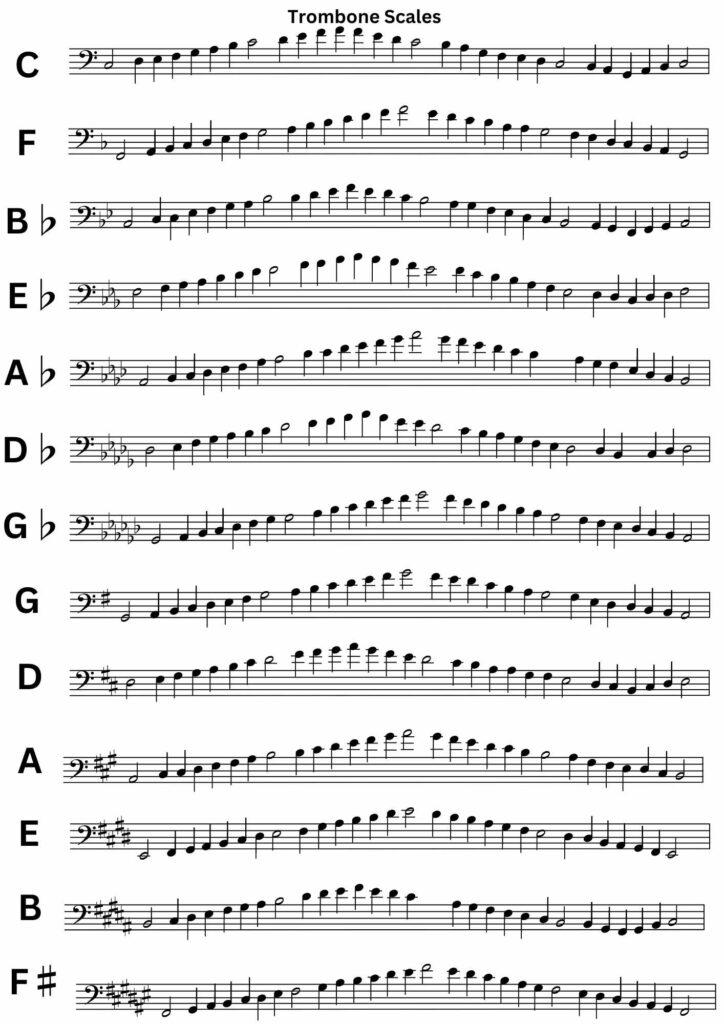Mastering The Trombone Chromatic Scale: 12 Easy But Must Tips And Techniques 2025

If you’re a beginner trombone player looking to improve your skills, mastering the trombone chromatic scale is essential.
We will explore what the trombone chromatic scale is, why it’s important to master it, and provide you with helpful tips and exercises to enhance your practice sessions.
From starting slow and gradually increasing speed to seeking guidance from a teacher or mentor, we’ve got you covered with everything you need to know to perfect this fundamental aspect of trombone playing.
Key Takeaways!
- Start slow and gradually increase speed while practicing the trombone chromatic scale to improve accuracy and control.
- Focus on proper technique, including posture, breath support, and articulation (embouchure) for a clear and consistent sound.
- Utilize various exercises — such as long tones and lip slurs — to develop muscle memory and master the chromatic scale in different registers and patterns.
What is the Trombone Chromatic Scale?
The trombone chromatic scale consists of twelve unique notes that span across all the half steps within an octave, forming the foundation of musical melodies and harmonies, and is essential for mastering various aspects of music theory.

In the context of the trombone, the chromatic scale serves as the fundamental tool for players to navigate through the entire range of the instrument with precision and accuracy. (Read more about “What Is Tenor Trombone: Range and Parts” ) By understanding and practicing the chromatic scale, you develop your technique, ear training, and overall musical comprehension.
Furthermore, the chromatic scale is widely utilized in jazz improvisation to create tension and release, adding color and depth to solo performances. In classical music, composers often incorporate chromatic passages to evoke different emotions or enhance the harmonic complexity of their compositions.
Why is it Important to Master the Trombone Chromatic Scale?
Mastering the trombone chromatic scale is vital for developing fluid technique and improvisation skills, which helps you to create harmonies and adapt to different musical styles, ultimately enriching your musical life.
It opens up a world of possibilities in terms of creating seamless transitions between notes, effortlessly incorporating accidentals, and navigating complex musical passages with precision.
For instance, in jazz music, fluidly moving through the chromatic scale allows the musician to add colorful dissonances and tensions, creating a dynamic and expressive performance.
Similarly, in classical music, mastering the chromatic scale enables the trombonist to execute intricate runs and melodic embellishments with finesse, adding depth and sophistication to their interpretations of classical repertoire.
(Read my post with “Trombone Beginners Guide To Kickstart Trombone”)
Tips for Practicing the Trombone Chromatic Scale
Practicing the trombone chromatic scale efficiently requires a structured approach that includes focusing on proper technique, developing consistent finger patterns, and maintaining correct embouchure position to ensure accuracy and fluidity in playing.
.jpg_01.jpeg)
1 Start Slow and Gradually Increase Speed
When practicing the trombone chromatic scale, it is crucial to start slow and gradually increase speed to ensure that each note is played cleanly and accurately.
By starting slow, beginners can focus on the correct fingerings and embouchure for each note, laying a solid foundation for more complex pieces. This method also allows players to develop muscle memory and control, which are essential for playing with precision and fluidity.
Gradually increasing the speed of the chromatic scale enables musicians to build endurance and stamina, preventing fatigue and maintaining consistent sound quality throughout the scale. Rushing through the scale often leads to sloppy technique and missed notes, hindering progress and overall performance proficiency.
2 Focus on Proper Technique
Focusing on proper technique, including maintaining a correct embouchure position, is essential for playing the trombone chromatic scale effectively.
Ensuring a relaxed yet upright posture is crucial for optimal breath control and sound production. When practicing, sit or stand with a straight back and shoulders relaxed. Focus on keeping your chin parallel to the ground and your chest lifted, allowing for unrestricted airflow. In terms of embouchure, remember to place the mouthpiece centered on your lips, with a firm yet flexible seal. Avoid excessive tension in your facial muscles to prevent fatigue.
(Read my post with “Best Trombone Mouthpiece Guide”)
- Another tip is to practice breathing exercises separately to enhance lung capacity and control.
- Incorporate regular breaks during practice sessions to prevent strain and maintain focus.

3 Use a Metronome
Using a metronome during practice helps in maintaining a consistent tempo and developing a strong sense of rhythm while playing the trombone chromatic scale.
One of the significant benefits of incorporating a metronome into your practice routine is that it enhances your overall timing accuracy. The metronome acts as a guide, helping you stay on beat and improving your coordination between different notes.
Another advantage is that it aids in building muscle memory, allowing you to internalize complex rhythms more efficiently. This can be especially useful when tackling difficult passages or intricate patterns in music.
When setting the metronome, start at a comfortable pace and gradually increase the tempo as you become more proficient. Consistency is key, so try to practice with the metronome regularly to reap its full benefits.
Incorporating the metronome into your daily practice sessions doesn’t have to be rigid. You can experiment with different rhythms, accents, and subdivisions to make your practice more engaging and effective.
4 Practice with a Tuner
Practicing with a tuner ensures that each note of the chromatic scale is played accurately, helping to develop a better sense of pitch and intonation.
Using a tuner not only sharpens your ear — it also enhances your overall musical prowess.
When practicing, pay attention to the needle (or digital display)!! Focus on identifying any variations in pitch and making the necessary adjustments.
Precise tuning elevates the quality of their performance. Regularly practicing with a tuner to maintain consistency and fine-tuning your musical skills!
5 Use Different Articulations
Incorporating different articulations, such as staccato and legato, into your practice routine can enhance your technique and versatility in playing the trombone chromatic scale.
Staccato articulation involves playing short, detached notes, which can help improve your precision and clarity in fast passages. On the other hand, legato requires smooth and connected notes, enhancing your ability to play lyrical phrases with fluidity and expression.
To practice staccato, try playing each note crisply and sharply without blending them together. For legato, focus on smoothly transitioning between notes, connecting them in a seamless flow.
6 Play in Different Registers
Playing the trombone chromatic scale in different registers helps to develop control and flexibility across the entire range of the instrument.

When you practice the chromatic scale in various registers, you enhance your ability to navigate through different pitch ranges seamlessly. This is crucial for trombone players, as the instrument demands versatility in playing from the lowest to the highest notes. By honing your skills in both high and low registers, you refine your embouchure and breath control, enabling you to produce consistent and clear tones regardless of the pitch.
One useful exercise is to start playing the chromatic scale from the lowest note you can comfortably reach, gradually moving up to the highest note and back down. This helps in building endurance and smooth transitions between registers, allowing you to play with confidence and accuracy.
7 Practice in Different Keys
Practicing the trombone chromatic scale in different keys is essential for improving your ability to play in various musical contexts and enhances overall technique.
Working on the chromatic scale across all twelve keys helps in developing a deep understanding of the trombone’s range and tonalities. It allows a musician to become more versatile and adaptable when faced with different musical pieces. An effective exercise is to start with one key, mastering it before moving to the next. Utilizing a metronome can aid in maintaining consistent tempo and accuracy while practicing chromatic scales.
- Breaking down the scale into smaller sections can further improve precision and fluidity.
8 Use Scales and Arpeggios as Warm-ups
Integrate scales and arpeggios into your warm-up routine to prepare your embouchure and fingers for practicing the trombone chromatic scale.
This method improves finger dexterity, hand-eye coordination, and overall muscle memory, allowing you to navigate complex passages more smoothly during your actual performance. Various scales (and arpeggios!) target different tonalities and intervals, helping you understand music theory.
Some beneficial warm-up exercises include major scales in different keys, minor scales, dominant 7th arpeggios, and diminished arpeggios.
9 Practice with Etudes and Studies
Etudes and studies are valuable tools for practicing the trombone chromatic scale, as they provide structured exercises that target specific technical challenges.
One benefit of incorporating etudes and studies into your practice routine is the focused improvement they offer on particular aspects of playing. Rather than aimlessly practicing scales, etudes and studies guide you through exercises designed to enhance your technique, tone quality, and overall proficiency. These resources also help build endurance and agility, crucial for mastering challenging passages.
Some highly recommended etude books that concentrate on chromatic scales are the ‘Melodious Etudes for Trombone’ by Joannes Rochut and ’60 Selected Studies for Trombone’ by H. Voxman. These books provide a comprehensive range of exercises that cater specifically to the development of chromatic scale proficiency.
10 Record Yourself
Record yourself while practicing the trombone chromatic scale, assess the technique, and make adjustments.
The recordings of practice sessions pinpoint areas of improvement that may not be as noticeable during the actual playing. Listen back to the recordings to identify flaws in your tone, articulation, intonation, and overall musicality.
Analyzing recordings helps you track your progress over time. You can compare older recordings with more recent ones to see how you have evolved and where you still need to focus your efforts.
11 Take Breaks and Rest Your Lips
Take regular breaks and rest your lips to maintain a healthy embouchure (mouth and lips form) and prevent fatigue while practicing the scales.
Pushing your lips too hard without giving them time to recover leads to strain and decreased performance. Incorporating short breaks every 20-30 minutes during practice sessions allows your embouchure muscles to relax and regain strength. It’s like giving your body a chance to recharge before diving back into playing.
Remember, QUALITY over quantity — practice efficiently with breaks rather than exhaust yourself in long sessions.
12 Seek Guidance from a Teacher or Mentor
A teacher or mentor provides personalized (to you) feedback and expert advice.
Having a mentor boosts your motivation and confidence as they offer encouragement and support throughout your learning journey. Experienced teachers introduce you to a network of like-minded individuals, opening doors to collaborations and performance opportunities.
To find the right instructor, consider their qualifications, teaching style, and communication skills. Look for someone who caters to YOUR learning pace and adapts their teaching methods to suit YOUR needs. Communicate openly with your mentor about your goals and areas you want to improve on, fostering a constructive learning environment.
During lessons, actively engage by asking questions, seeking clarification, and practicing consistently between sessions. Use resources provided by your teacher and set clear practice goals to track your progress.
Exercises to Master the Trombone Chromatic Scale
To effectively master the trombone chromatic scale, incorporating a variety of exercises into your practice routine is essential for developing both technical proficiency and musicality.
Long Tones
Practicing long tones is fundamental for developing a strong embouchure and a controlled, even sound across all notes of the chromatic scale.
These exercises help focus on breath control, as sustaining a single pitch for an extended period enhances lung capacity and endurance. Long tones improve intonation, tone quality, and overall playing consistency.
To incorporate long tones into daily practice, start with sustained notes in the middle register for around 30 seconds and gradually increase the duration as your endurance builds. Utilize a tuner to ensure pitch accuracy and listen attentively to the subtleties in your sound.
Lip Slurs
Lip slurs are exercises for improving flexibility and control for smoother transitions between notes in the scales.
These exercises target the muscles you use when changing between different pitches — navigate up and down the musical scale effortlessly! When practicing lip slurs, keep a steady air stream moving between the notes. Start with simple two-note slurs and gradually progress to more complex patterns involving larger intervals.
One effective method is to use a metronome to set a steady pace and ensure consistent timing. Paying attention to your embouchure and making slight adjustments as needed can help refine your technique and produce cleaner, more precise slurs.
Scale Patterns
Incorporating various scale patterns into your practice routine can enhance your ability to navigate the chromatic scale with ease and precision.
Practicing diverse scale patterns not only improves your finger dexterity but also strengthens your understanding of music theory. By familiarizing yourself with scales such as the major scale, natural minor scale, pentatonic scale, and blues scale, you can develop a well-rounded foundation for improvisation and composition.
For instance, practicing the major scale in all keys can help you internalize the unique intervals within each scale, allowing you to effortlessly transition between different tonalities. Exploring exotic scales like the Phrygian dominant scale or the whole-tone scale can add color and sophistication to your melodic phrases.
Arpeggio Exercises
Arpeggio exercises are crucial for developing a strong sense of harmony and fluid technique when playing the chromatic scale on the trombone.
By practicing arpeggios, trombone players can improve their finger dexterity, overall coordination, and muscle memory. These exercises help in training the ears to recognize different intervals, enhancing musicianship and improvisational skills. Some common arpeggio exercises include major, minor, diminished, and augmented arpeggios. It is recommended to start with slow and deliberate practice, focusing on clean and even articulation for each note. Gradually increase the tempo as proficiency improves. Integrating arpeggio exercises into daily practice routines can lead to significant improvements in tone production and overall performance ability.
Chromatic Scales in Different Patterns
Practicing chromatic scales in different patterns can improve your ability to play complex musical passages with confidence and accuracy.
One valuable pattern to practice is ascending and descending chromatic scales, starting on each finger of your hand. This exercise helps in developing finger independence and control.
Another effective method is playing chromatic scales in thirds, which enhances coordination between hands and fingers.
Practicing chromatic scales with rhythmic variations like triplets or sixteenth notes can improve your sense of timing and precision.
Experimenting with different articulations, such as staccato or legato, adds depth to your musical expression.
Remember, consistency is key to mastering these patterns and reaping the benefits in your playing.
Common Mistakes to Avoid When Practicing the Trombone Chromatic Scale
Avoiding common mistakes when practicing the trombone chromatic scale is crucial for ensuring steady progress and building a solid foundation in technique and musicality.
Playing with Poor Posture
Playing with poor posture can hinder your ability to produce a clear, resonant sound and negatively impact your overall technique.
Good posture plays a crucial role in not only optimizing your musical performance but also in maintaining long-term physical health. By sitting or standing with proper alignment, you allow for better airflow and muscle engagement, leading to improved sound projection and control. To correct your posture, start by aligning your ears with your shoulders and keeping your back straight.
Focus on relaxing your shoulders and engaging your core muscles to support your spine. Avoid slouching or leaning forward excessively, as this can strain your neck and back over time. Remember to take short breaks during practice sessions to stretch and reset your posture.
Not Using Proper Breath Support
Proper breath support is essential for producing a strong, consistent sound and avoiding fatigue while practicing the chromatic scale.
One tip for improving breath support is to practice deep breathing exercises regularly. This can help strengthen the diaphragm and increase lung capacity. Focusing on maintaining a steady flow of air while singing or playing an instrument can greatly enhance performance.
Engaging the core muscles is also crucial for effective breath support. Strengthening the abdominal and lower back muscles through exercises like planks or yoga can improve breath control and stability. Staying hydrated and maintaining good posture can further aid in proper breath support.
Rushing Through the Scale
Rushing through the chromatic scale can lead to sloppy technique and missed notes, hindering your overall musical development.
One of the key reasons why avoiding rushing is crucial in music practice is the emphasis on precision and accuracy. By taking your time to play each note carefully, you develop a strong foundation for your technique. This ensures that you not only hit the right notes but also maintain the desired quality and tone.
To maintain a steady pace during practice, it is helpful to break down the passage into smaller sections and focus on mastering each one before moving on to the next. Practicing with a metronome can help you establish a consistent tempo and improve your timing.
Neglecting the Fundamentals
Neglecting the fundamentals of trombone playing, such as proper embouchure and finger patterns, can impede your progress in mastering the chromatic scale.
To truly excel in playing the trombone, one must embrace these foundational aspects. Developing a strong embouchure not only improves tone quality but also enhances your overall control of the instrument. Ensuring consistent finger patterns will enable smoother transitions between notes and facilitate more complex compositions. Integrating fundamental exercises into your practice routine is essential for steady improvement.
Start each session with simple lip slurs and scales to hone your embouchure and finger coordination. Dedicate time to perfecting these basics, and you’ll notice a remarkable difference in your playing prowess.
Not Listening to Your Sound
Not listening to your sound can result in poor tone quality and intonation issues, which are critical when practicing the chromatic scale.
Active listening during practice is a crucial skill that can greatly enhance your musical performance. By paying close attention to the nuances of your sound, you can identify areas for improvement and make necessary adjustments. To improve your listening skills, consider setting aside dedicated time to focus solely on your playing without distractions. This focused practice can help you pick up on subtle details and make corrections in real-time.
Active listening also involves being receptive to feedback from teachers or peers. Constructive criticism can provide valuable insights into your playing and help you address any issues that may be affecting your tone quality and intonation. Recording your practice sessions and listening back can help you gain a different perspective on your performance, allowing you to pinpoint areas that need improvement.






